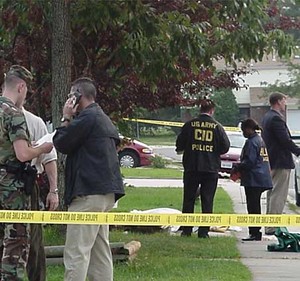When you turn your television to CSI or Law & Order or Bones, do you pay careful attention to the forensic science portrayed on screen? Although most crime shows have forensic consultants on staff, much of what you see is usually pure fiction. Unfortunately, real crime scene investigators and medical examiners must spend years combing through evidence and waiting for test results, which is nothing like the hour-long dramas that depict law enforcement personnel solving crimes in less than a few days.
Not only that, but most violent crimes in the United States are never solved. The chain of evidence must be kept in-tact in order for it to hold up in court, and that is only if the evidence supports the popular theory of the D.A. and the police investigators. Not only are there scores of differences between TV forensics and real forensics, but many real-life professionals believe that crime shows are dangerous for the public. If the public thinks that crimes are solved the way they are on television, real investigations can be compromised.
Length of Time
One of the major differences between TV forensics and real forensics is the length of time it takes to solve a crime. For example, on Law & Order, suspects are usually brought to trial immediately. In real life, however, a murder or rape suspect would most likely wait years for his or her day in court. Not only that, but test results aren’t returned in a matter of hours, as they are seen on CSI and Bones. Serology testing, for example, usually takes at least three weeks to come back from the lab, and includes testing of all bodily fluids, including blood, saliva and semen.
The same goes for ballistics, toxicology and digital forensics. Forensic labs are usually built in direct proportion to the size of the city; even in a large metropolitan area like New York or L.A. or Miami, there won’t be sufficient personnel to return lab results within a couple of hours (or even a couple of days) because of the sheer volume of cases.
Physical Evidence Collection
If you watch any of the crime shows on television, you should be able to pick out some of the differences between TV forensics and real forensics, especially when it comes to the collection of physical evidence. It isn’t enough for a police officer or crime scene investigator to wear gloves while processing a crime scene. Additional efforts must be made to preserve evidence and to avoid the disruption of fingerprints and fibers.
For example, you’ll often see forensic professionals picking up a gun by sliding a pencil behind the trigger. This is never done in “real life” because the pencil breaks the chain of evidence. To pick up a gun used in a crime, CSI professionals would simply grasp it between two gloved fingers, preferably on the butt where ridges will prevent the lifting of fingerprints, anyway.
Presence of Evidence
One of the main differences between TV forensics and real forensics is that on television, there is always evidence. In real life, some criminals are lucky (or smart) enough not to leave any evidence behind. This is one reason why many violent crimes go unsolved; if the police don’t have any leads, it becomes a cold case. It would be nice if physical evidence tied the ends of every case just right, giving the police and the prosecutor all they need to convict the guilty, but it just doesn’t happen that way very often.
Performance of Testing
On television crime shows, all of the forensic testing is conducted by the medical examiner or a police laboratory, when this isn’t the case in real-life forensics. In many cases, evidence must be transported to other labs around the country where specialists can properly handle the materials. It isn’t possible for every forensics lab to have every professional they might need to solve a case, and much of the evidence collected in criminal investigations is taken to university labs for analysis.
Not only that, but the medical examiner isn’t able to conduct all of the necessary tests by him- or herself. Thousands of professionals specializing in very different fields are required to process all of the evidence found at a crime scene.
The differences between TV forensics and real forensics are astonishing, and while the popular crime shows are entertaining to watch, they do not depict real-life investigations. It’s important that you understand the distinction, particularly if you are ever a witness to a violent crime.



